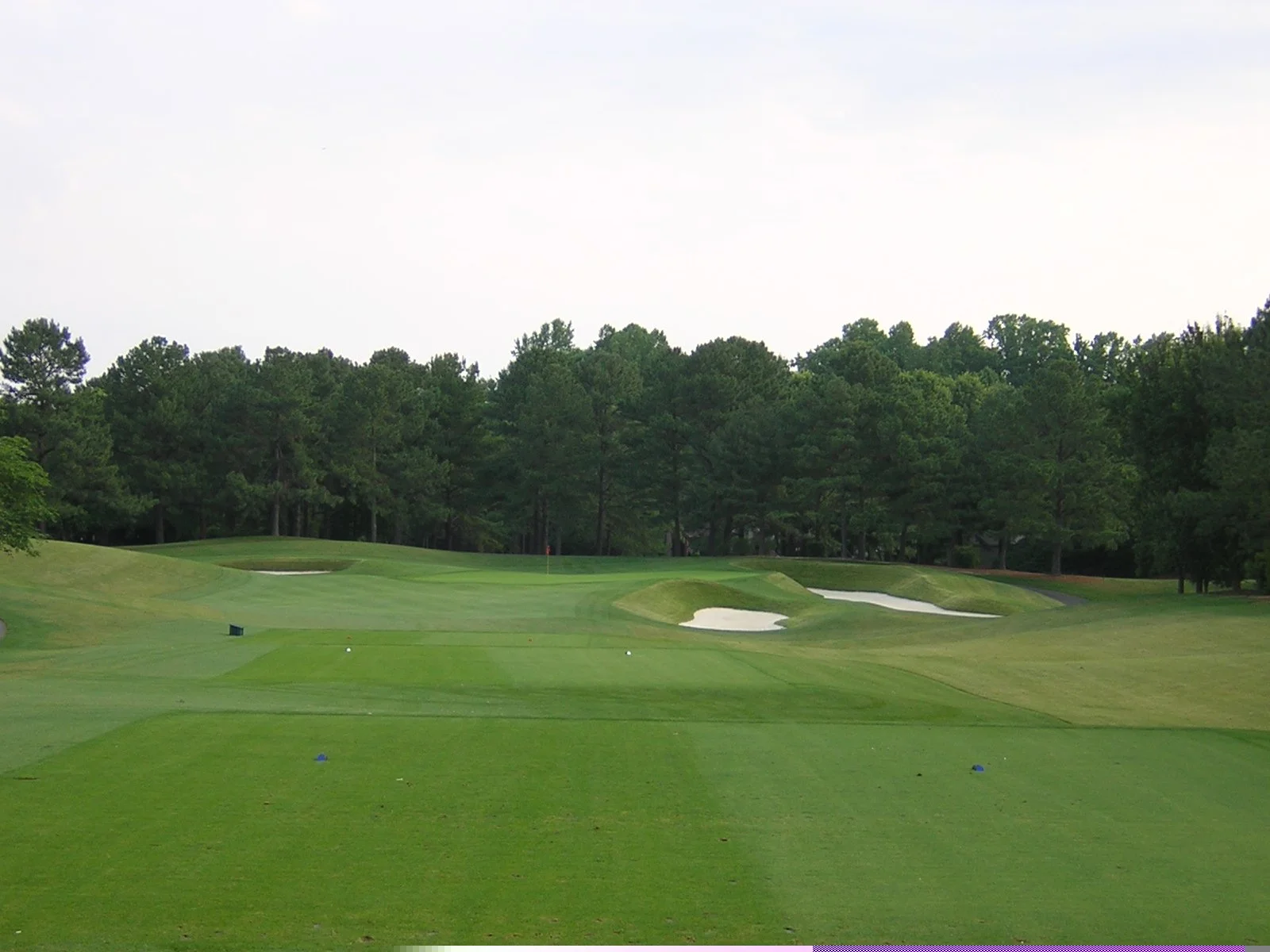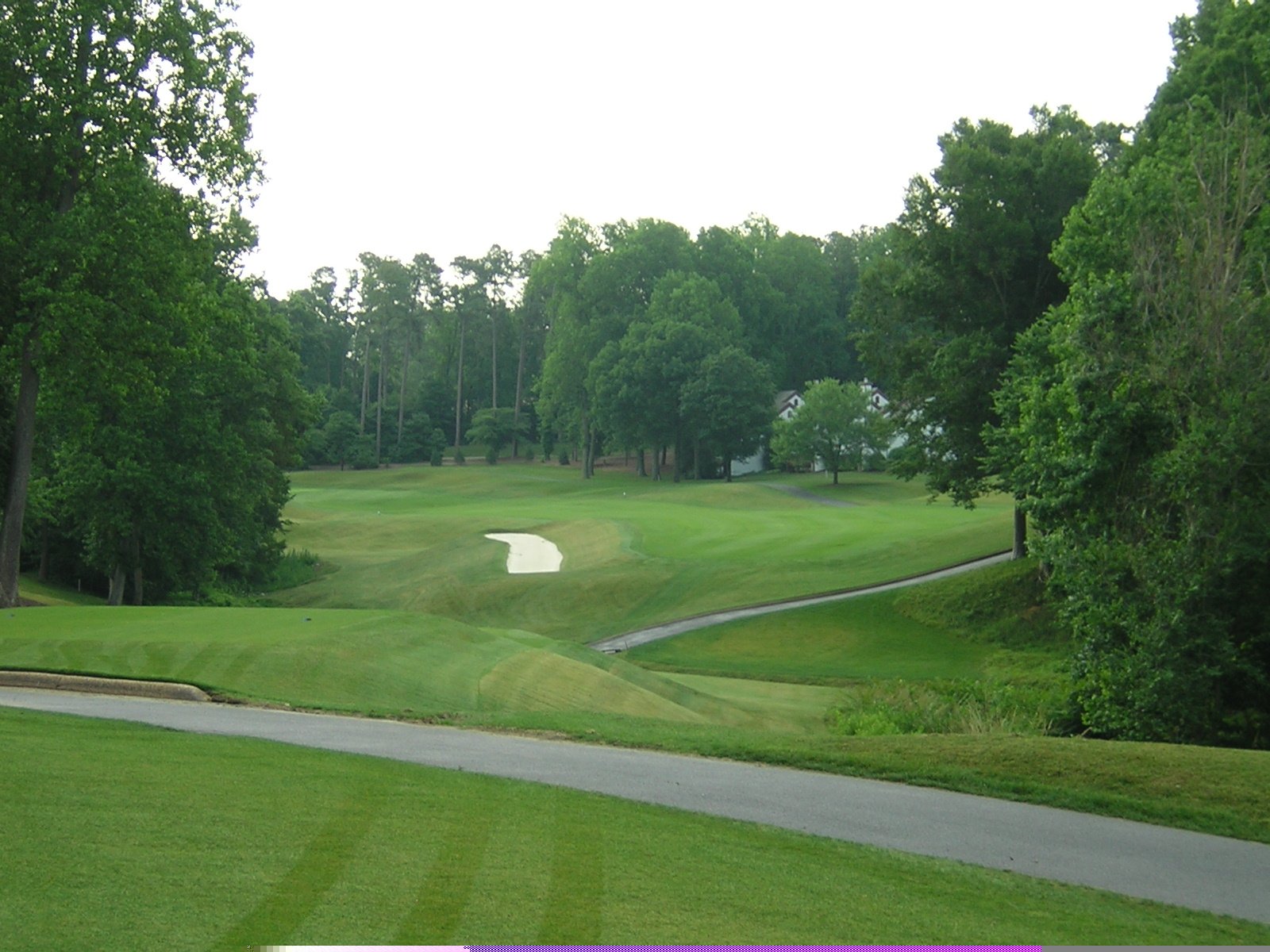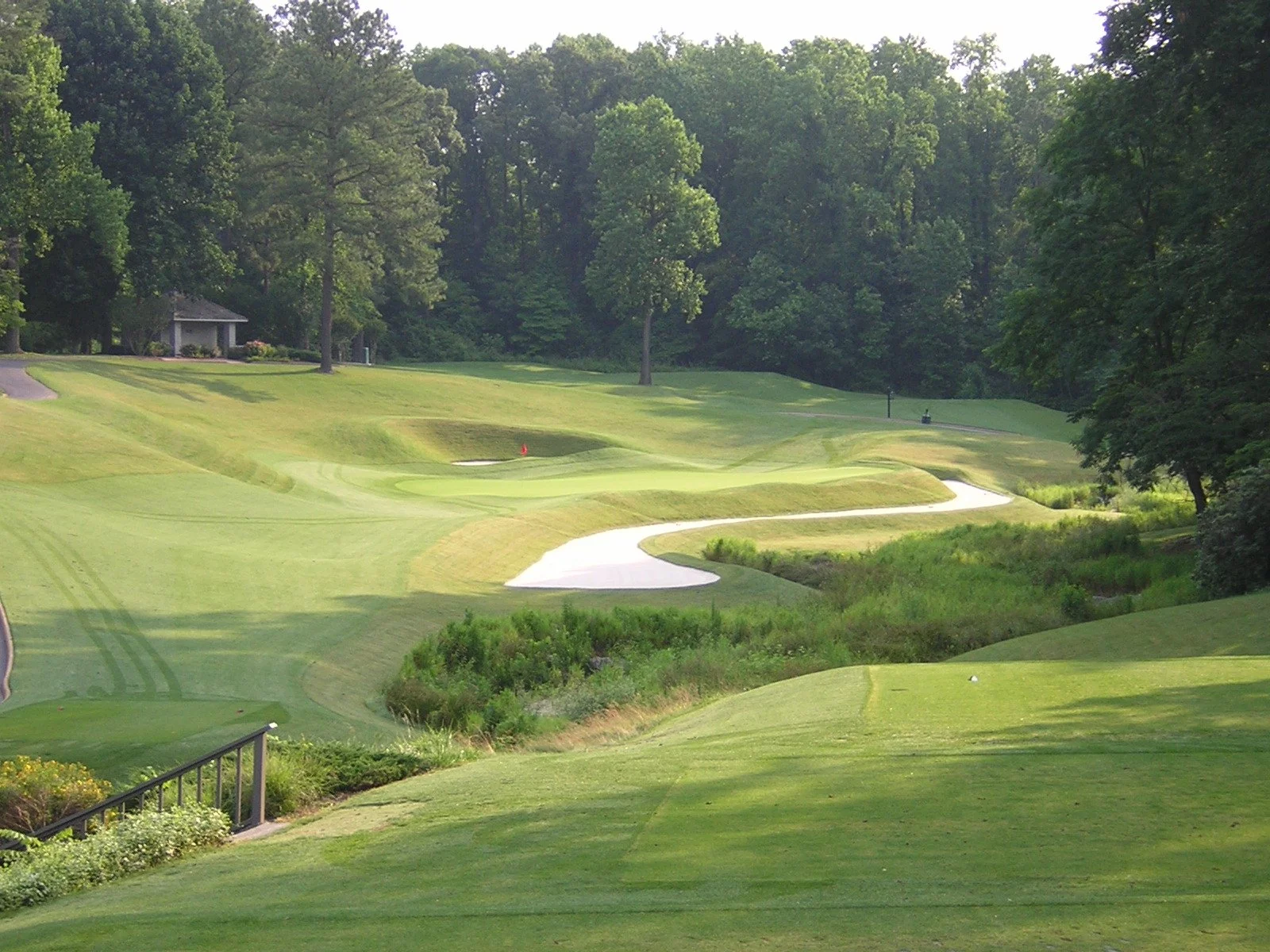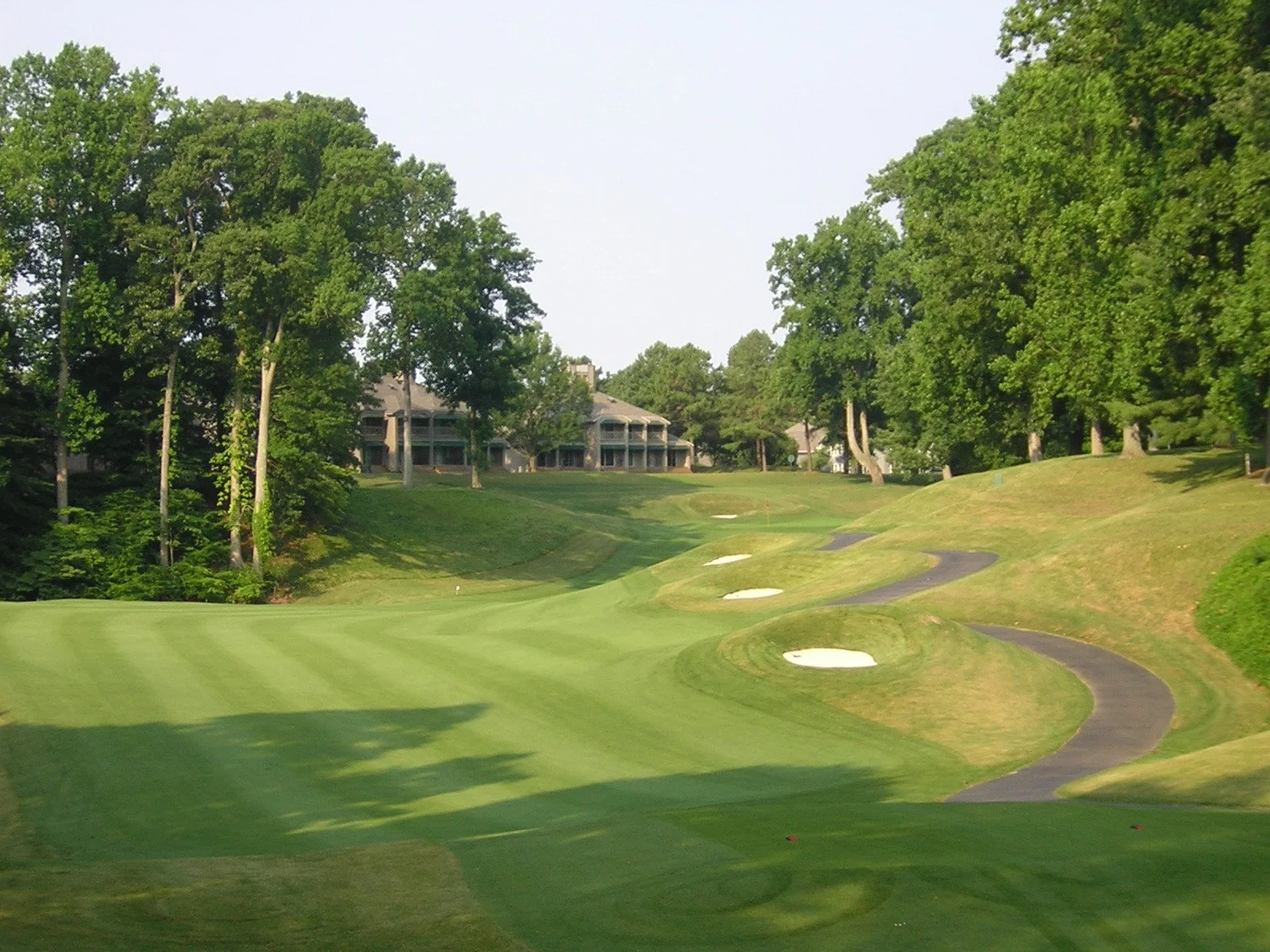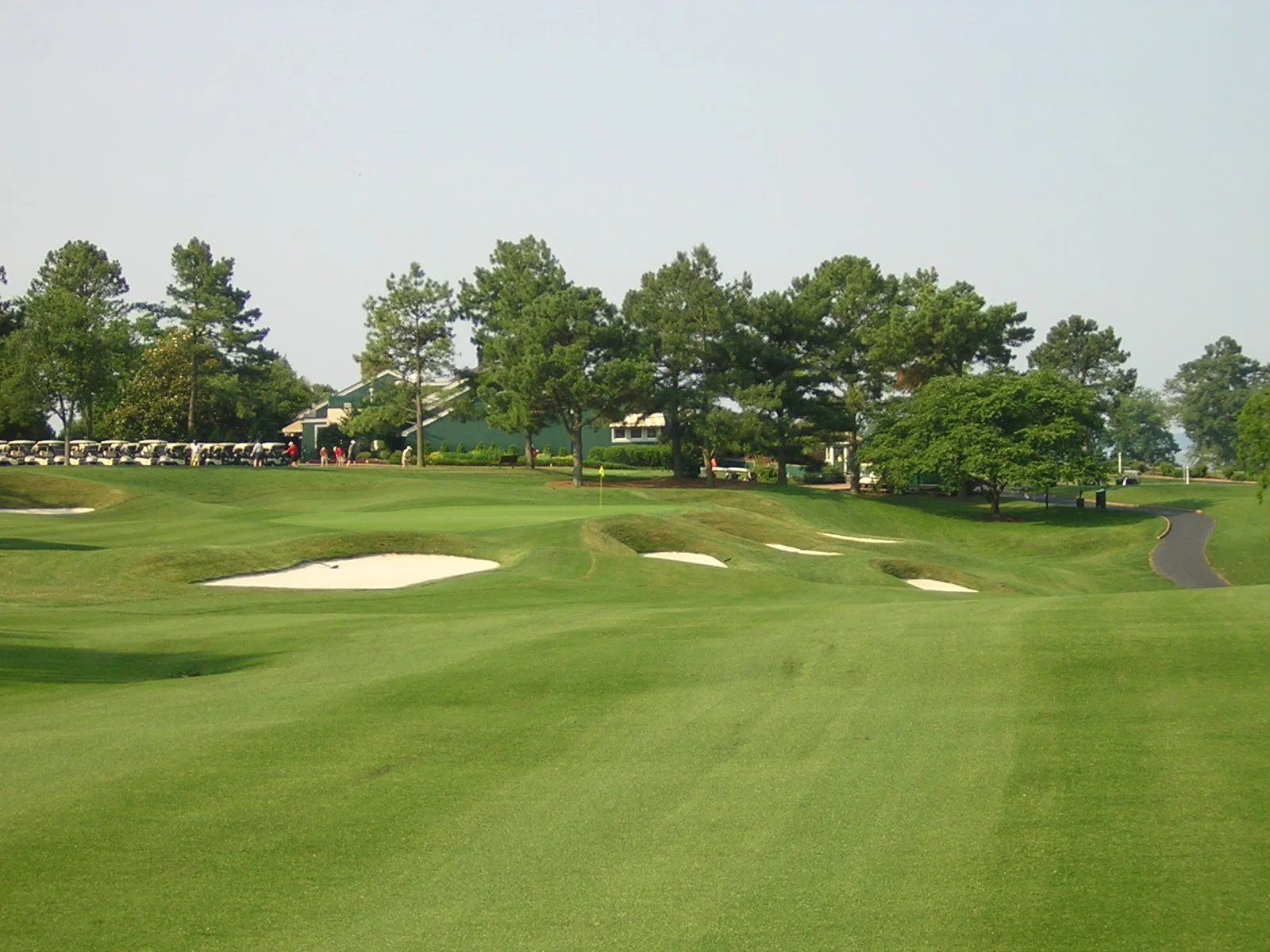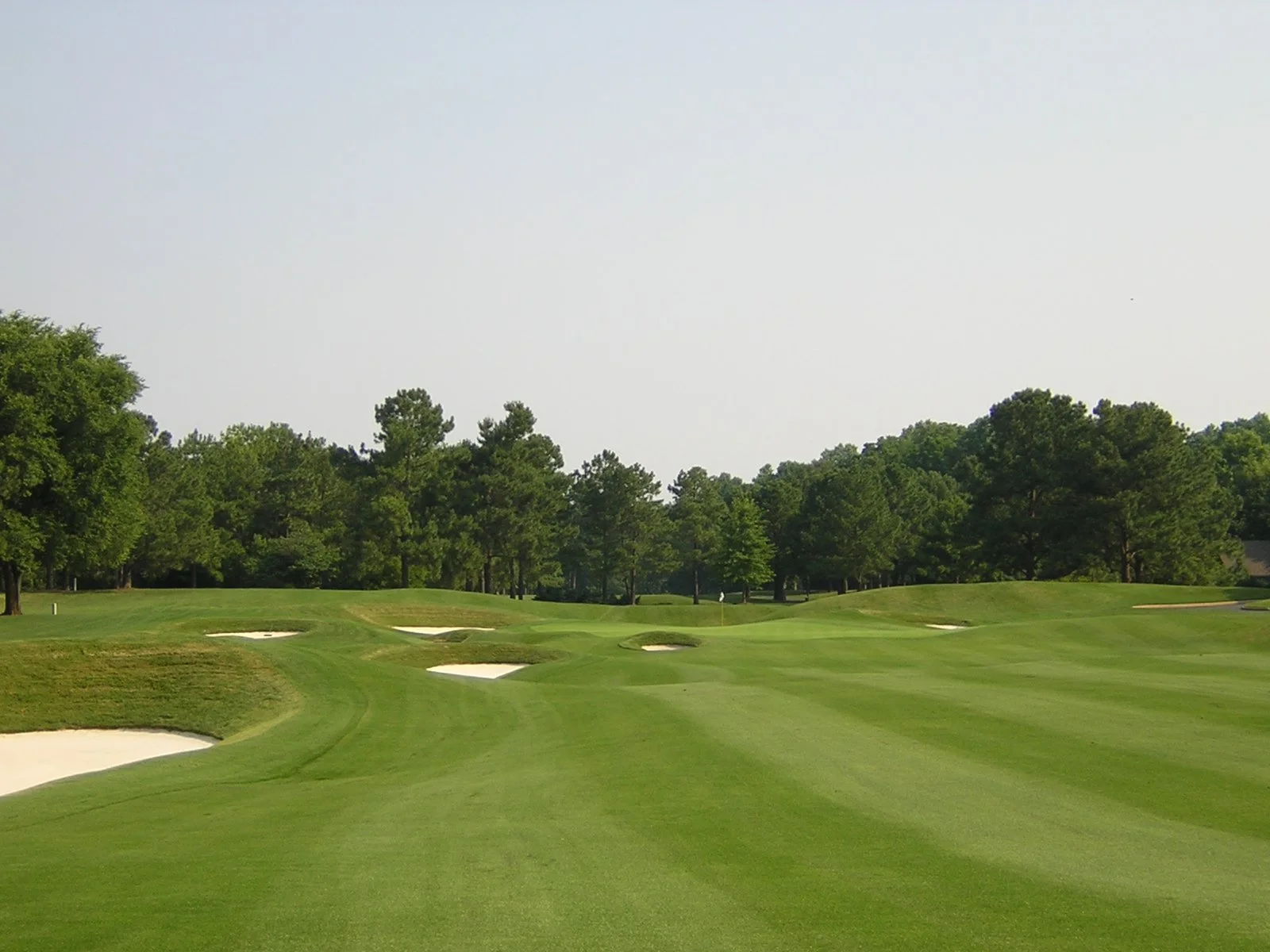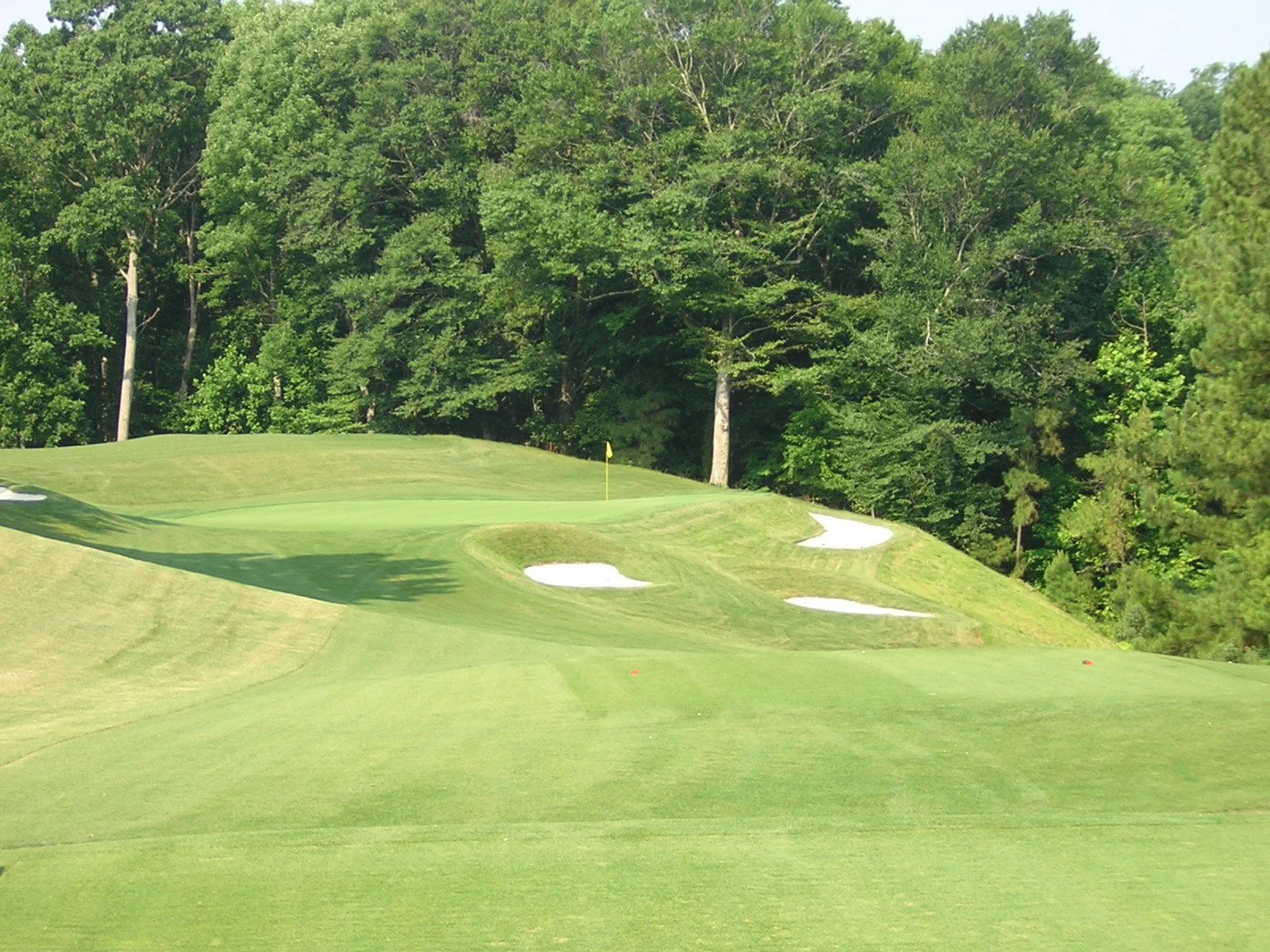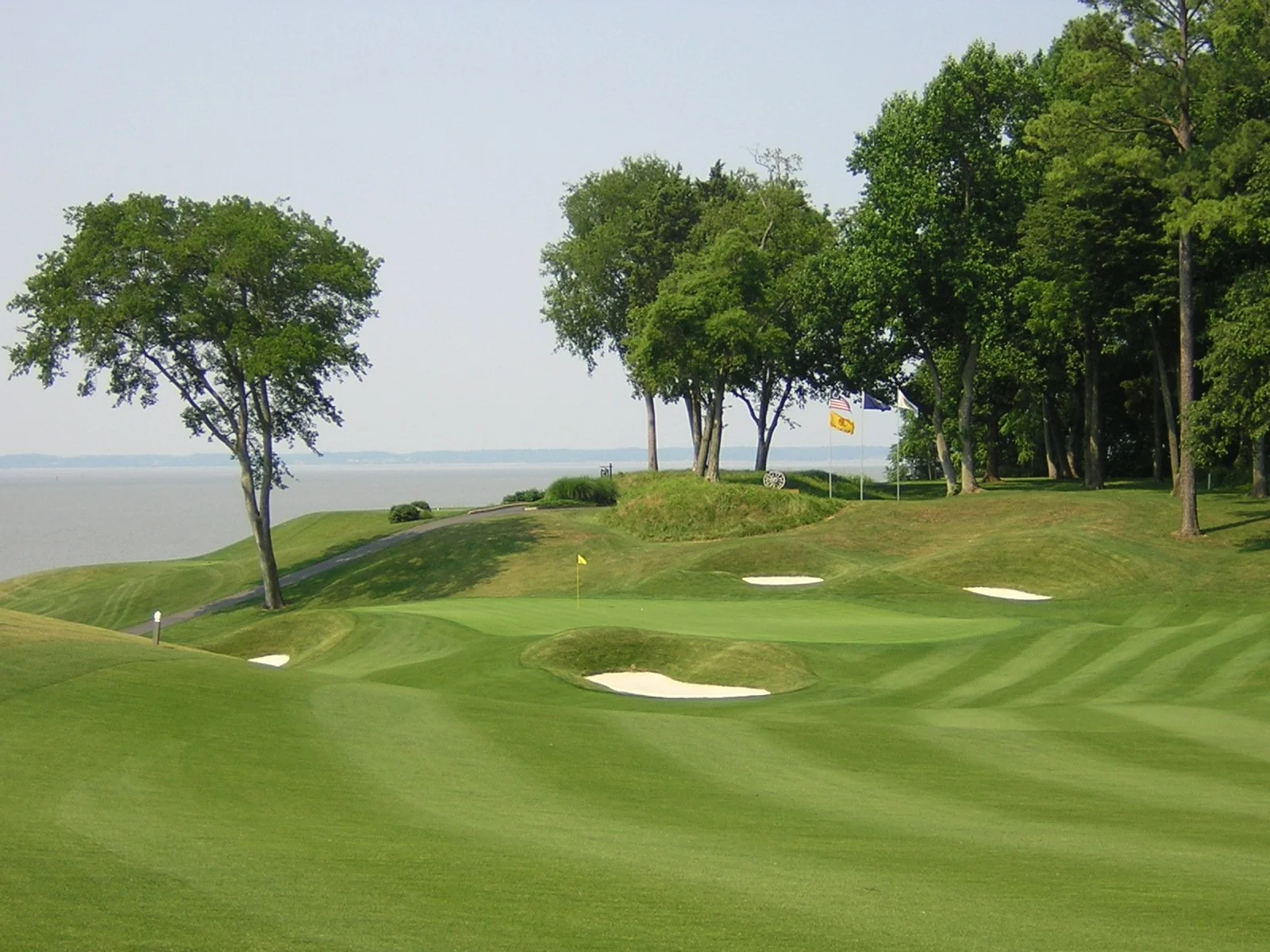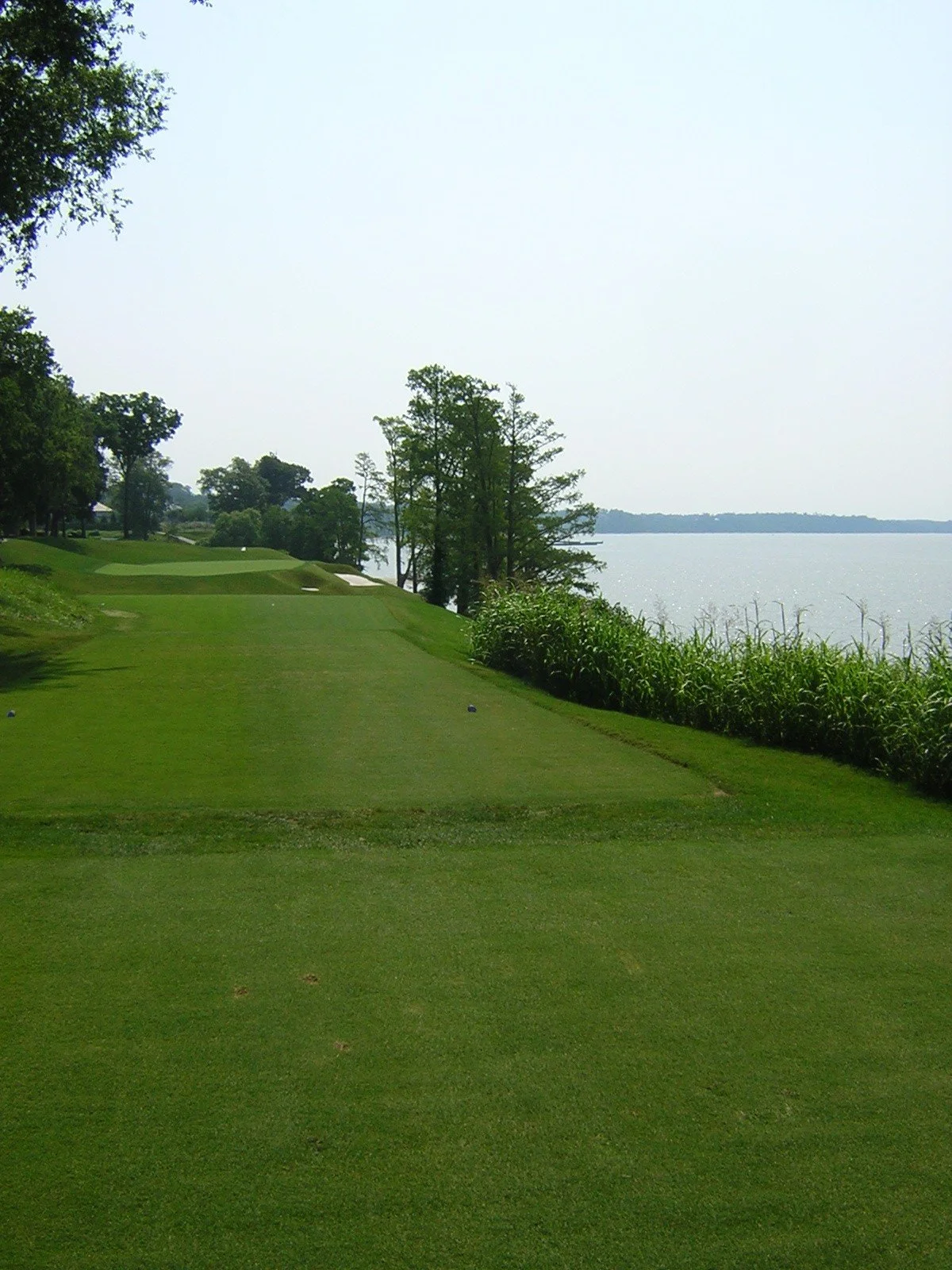KINGSMILL RESORT (RIVER Course)
Course Architect: Pete Dye (1975, re-design, 2004),
Ault, Clark & Associates (re-design)
Year Opened: 1975
Location: Williamsburg, Virginia
Slope: 139. Rating: 74.7
Par: 71
Yardage: 6,831
Hole-by-Hole: 1 - Par 4 369 Yds 10 - Par 4 413 Yds
2 - Par 3 198 Yds 11 - Par 4 408 Yds
3 - Par 5 518 Yds 12 - Par 4 396 Yds
4 - Par 4 439 Yds 13 - Par 3 175 Yds
5 - Par 3 173 Yds 14 - Par 4 374 Yds
6 - Par 4 369 Yds 15 - Par 5 503 Yds
7 - Par 5 525 Yds 16 - Par 4 458 Yds
8 - Par 4 419 Yds 17 - Par 3 177 Yds
9 - Par 4 467 Yds 18 - Par 4 450 Yds
Par 36 3,477 Yds Par 35 3,354 Yds
Key Events Held: Anheuser-Busch Golf Classic (1981-95),
Michelob Championship at Kingsmill (1996-2002),
Michelob Light Open (2003),
Michelob ULTRA Open at Kingsmill (2004-09),
Golf Channel's Big Break III (2005),
Kingsmill Championship (2012-17), Kingsmill Championship presented by GEICO (2018), Pure Silk Championship (2019-21).
Awards Won: #8 America's Best State-by-State Public Access (Golfweek) 2006,
4 1/2 stars by Golf Digest Best Places to Play 2005,
Silver Medal Resort (Golf Digest, Golf Magazine),
Top 100 Places You Can Play (Conde Naste),
Top 100 Resort Courses (Golfweek) 2005,
Top 100 Residential Golf Courses (Golfweek), 2005,
Top 75 Golf Resorts (Golfweek, Golf Digest).
Website: kingsmill.com
HISTORY: The Kingsmill property dates back to the early 1600s, where the first Englishman dropped anchor in the James River. Although they settled upstream in Jamestown, the Virginia Company of England granted 300 acres to Richard Kingsmill, a member of the organization. Col. Lewis Burwell III, a member of the Governor's Council, inherited the land from his grandfather and named it Kingsmill after the original owner. Burwell's Landing was an integral part of the American Revolution and can be seen from the 17th hole.
Fast forward to present time. The Kingsmill Resort and Spa is one of the Anheuser-Busch Companies in Williamsburg, part of the 2,900 protected acres along the James River. The Resort features 63 holes of golf, tennis, a full-service spa and marina, numerous restaurants, indoor and outdoor pools and of course, Busch Gardens Europe and Water Country USA. The signature venue at Kingsmill Resort is, without a doubt, the River Course designed by legendary architect Pete Dye.
One of the most innovative course designers, Dye has left his mark on many tracks around the world. In the United States alone, Whistling Straits, Pete Dye Golf Club (WV), The Golf Club (OH), The Honors Course (TN), TPC at Sawgrass (Stadium Course) and the Ocean Course at Kiawah Island, are all ranked in the top-20 of America's Best top-100 Modern Courses by Golfweek magazine. Let's not forget Blackwolf Run, Harbour Town Golf Links, Long Cove,
Crooked Stick, Bulle Rock and Oak Tree, all of which have hosted professional and amateur events.
In 2004, Dye returned almost 30 years later to supervise a multi-million dollar facelift, as he recontoured the greens, reshaped fairways and rebuilt bunker complexes. The River Course at Kingsmill has held some lofty tournaments over the years.
After staging the event for years in California, Anheuser-Busch brought the tournament to Kingsmill Resort for the first time in 1981. John Mahaffey outdueled Andy North by two shots for the sixth of his 10 career PGA Tour wins.
Calvin Peete became the first player to win back-to-back at Kingsmill with his victories in 1982-83. Peete won the weather shortened event in 1982 by two shots over Bruce Lietzke and then captured the '83 event by one over Tim Norris.
Ronnie Black set a new tournament record score of 267 when he titled in 1984, as he edged Willie Wood by a stroke. Attempting to become a two-time champion at this event, Mahaffey lost in a playoff to Mark Wiebe in 1985.
Fuzzy Zoeller won the last of his 10 PGA Tour titles in 1986, as he defeated Jodie Mudd by two shots. Mark McCumber captured the first of his two Anheuser-Busch crowns with a one-shot win over Bobby Clampett in 1987. McCumber would later title in 1994. After making just three cuts in his previous 16 events, Tom Sieckmann shot four rounds in the 60s and then defeated Wiebe in a playoff for his only PGA Tour win. Mike Donald closed out the '80s with a playoff win over Tim Simpson and Hal Sutton in 1989. Donald closed with a 65 to reach the extra session, as he won for the first time in his career.
Lanny Wadkins set a new tournament record in 1990, as he shot four rounds in the 60s for a total of 266 and a five-shot win over Larry Mize. Mike Hulbert parred the first extra hole in 1991 to defeat Kenny Knox. Hulbert's total of 266 tied Wadkins' mark set the previous season. Hulbert's victory was the third and last of his career. During the tournament the course record of 62 was tied by Ian Baker-Finch, Knox and Brian Claar.
David Peoples won for the second time in his career in 1992, as he carded four sub-70 rounds to defeat Bill Britton and Ed Dougherty by one shot. Four strokes off the pace after three rounds, Jim Gallagher Jr. shot a sizzling 65 on the final day to defeat Chip Beck by two shots and win his second career title. Local favorite Curtis Strange equaled his best finish ever at this event, as he tied for third with four rounds in the 60s.
Bob Lohr opened the event with a course-record 61, but was unable to sustain his play, as he faded into a tie for seventh, as McCumber won by three shots over Glen Day. McCumber shot rounds of 65-66 over the weekend for the win.
Ted Tryba became a first-time winner, as he posted a one-shot win over Scott Simpson in 1995. Tryba shot four rounds in the 60s, including back-to-back 68s over the weekend. Scott Hoch led wire-to-wire in 1996, as he set a new tournament record of 265 en route to a four-shot win over Tom Purtzer.
David Duval captured back-to-back titles in 1997-98. Duval's first career title at the Michelob Championship opened the floodgates, as he won three times in '97 and then four more events in 1998 and in 1999. Three shots back in 1997, Duval fashioned a four-under 67 to reach a playoff with Grant Waite and Duffy Waldorf and then birdied the first extra hole for the win. Duval's
1998 victory was less dramatic, as he won by three shots over Phil Tataurangi with four rounds in the 60s.
Notah Begay III won the second of his four career titles, as he defeated Tom Byrum on the second hole of a playoff in 1999 with a par. Third-round leader Mike Weir closed with 70 and finished one back.
David Toms continued the playoff trend at Kingsmill, as he clipped Weir with a par on the first extra hole in 2000. Toms trailed by two shots heading into the final round, but carded a 66 to force the playoff with Weir, who shot 64 on Sunday. Toms joined the ranks of the back-to-back champions with his victory in 2001. He started with 64 and closed with 68 for a one-shot
advantage over Kirk Triplett.
The PGA Tour's era at Kingsmill ended in 2002, as Charles Howell III became the sixth and final first-time winner of this event. Howell led the event in par-5 scoring (4.08) and was 11-under on the 12 par-5 holes. Howell's total of 270 edged Scott Hoch and Brandt Jobe by two shots. In 20 appearances at Kingsmill, Hoch made 19 cuts, tying him with Curtis Strange in that category.
Hoch also posted eight top-10s and six top-5s. Strange was the only player to compete in all 22 tournaments since the event moved from California in 1981 and had recorded seven top-10s.
The LPGA Tour arrived on the scene in 2003 with the Michelob ULTRA Open at Kingsmill. They say that the cream rises to the top and that is exactly what has happened in this event, as Grace Park, Se Ri Pak, Cristie Kerr and Karrie Webb have titled here the first four years.
In 2003, Grace Park rebounded from a double-bogey start on the first hole to shoot an even-par 71 and post a one-shot win over Webb, Lorena Ochoa and Kerr. Leading by one with two holes remaining, Park got up-and-down for par on 17 and then sank a 20-footer for par on the last to secure the win.
Four strokes back when the final round began, Pak carded a six-under 65 to come from behind and defeat Ochoa and Juli Inkster by two shots for her 22nd career title. With the victory in 2004, Pak qualified for the LPGA Tour Hall of Fame, although she will not be enshrined until 2008. Making her first appearance at this event, amateur sensation Michelle Wie finished tied for 12th.
With chances to win in '03 and '04, Kerr finally broke through at Kingsmill with a five-shot win over Jill McGill in '05. Kerr, who tied for second in 2003 and tied for sixth in 2004 after holding the third round lead, opened with three consecutive 68s. Despite a fourth-round score of 72, Kerr was able to cruise to her fifth career title.
Webb dominated this event in 2006, as she posted a tournament-record score of 270 for a seven-shot advantage over Ochoa and Hee-Won Han. Webb shot four sub-par rounds for her wire-to-wire victory, her 32nd on the LPGA Tour. Defending champion Kerr finished tied for fourth. In four appearances at this event, Kerr had four top-six finishes, nine rounds out of 16 in the 60s, is a
cumulative 29-under-par and has earned over $600,000.
Winners of this former LPGA Tour event read like a who’s who’s, as victors include Annika Sorenstam, Suzann Pettersen, Lexi Thompson, Ariya Jutanugarn (twice) and Kerr (three times).
REVIEW: What a perfect opening hole. Not too hard, not too easy, just the right kind of start to ease you into your round. Just 369 yards from the gold tees, the first features a two-tiered fairway with plenty of room to the left. Stay clear of the deep pot bunker in the right-center of the landing area, as to leave yourself with a short iron to a fairly large green. The putting surface is not too tricky, however a bunker short-left and one right must be avoided.
Although its considered the 17th handicap hole, the second is the longest par-three on the course, just under 200 yards in length. A mid to long iron is needed to reach the green that is protected on the right by two long, deep traps. A high fade toward the left should produce the best results in your effort to make par.
A wonderful par-five, the third is a tempting dogleg left that the big hitters can give it a go to get home in two. After a successful tee ball down the left side, the player is left with roughly 225 to the green. The difficulty here is that the green is elevated and a narrow target. Water looms left of the green, not to mention a long, trench-like bunker. The smart play is to lay up in the left fairway, thus leaving yourself with a little wedge to the putting surface. Nothing tricky on the green, so you should have a reasonable chance at birdie.
The hardest hole on the course, the fourth is a bear of a par-four, stretching 439 yards from the back tees. Doglegging to the left, the key is to play toward the right-center of the fairway, as the landing area falls hard to the left toward deep rough, sand and a creek that runs down the entire left side. A medium iron remains to a fairly long green, with a pair of very deep traps on the left side. Par is a wonderful score here.
One of the signature holes at the River Course, the fifth is a beautiful par-three of 173 yards. A meandering creek and a 50-yard trap cover the entire right side through the green. Spectator mounding supports the left side and behind the green, along with a very deep trap. A back-right flag could be the toughest pin placement on the hole, which makes club selection so important.
Playing from an elevated tee, the sixth plays uphill to a wide open fairway. The difficulty on this fairly short par-four is the second shot, which plays to an elevated and undulating green. Only 32 yards in depth, the putting surface has numerous levels, which could make two-putting quite a chore.
Another risk-reward par-five, the seventh necessitates a solid drive down the fairway to have any shot at getting home. Three fairway traps, two right and one left guard the go-zone. A drawing, fairway metal will be required to reach the green, which sits left of the fairway. Any shot missed left and short will sit well below the green in deep rough or worse, two tough traps. The right side of the green is no bargain either with two traps guarding the narrow putting surface. This hole can be had, but err with caution.
The eighth is a solid, dogleg right par-four from an elevated tee box. Three deep pot bunkers guard the right side of the landing area, while one trap and deep rough flank the left. Not only that, any shot missed left will trundle down toward water which sits well below the fairway. The second shot will play uphill to an elevated green with sand right and left and spectator mounding deep. The narrow putting surface slopes from back to front, so play below the hole for the best results.
The opening nine closes with the longest par-four on the course, 467 whopping yards. The hole bends slightly to the left and requires a massive blast off the tee to have any shot at getting an iron on the ball. Sand left and right guards the landing area, but the difficulty arises by the green. The elevated surface is protected by a series of well-defined traps right, one short and one left. Any shot offline to the right will be well below the green, making for a difficult up-and-down. The kidney-shaped green is one of the longest on the course at 44 paces, making two-putting a real chore.
The inward nine features four par-fours over 400 yards and three of the best finishing holes in golf. The 10th is a solid par-four that bends to the right with numerous traps guarding both sides of the fairway. The green is protected only on the right side by three bunkers. The putting surface is fairly flat, so birdies can be made.
Eleven is another of those 400-plus holes, this time bending to the left. The key is the tee shot. A wide fairway is there for the hitting, however any ball toward the left side will be gobbled up by a 55-yard long trap. A medium iron will remain to a putting surface that is protected by numerous traps, seven within 40 yards of the green. The short grass is long and narrow with the bailout area to the right. A tough hole to get it close.
Just under 400 yards, the 12th doglegs to the left, devoid of sand until the green. The defense on the hole is the tree-lined fairway. Three metal should be plenty to split the landing area, leaving just a short iron to a sloping green. The putting surface features only one trap, deep-left. The green is slightly raised and any ball right of the green will kick down toward the rough and trees. This is no time to lower your guard.
The first one-shotter on the back nine, the 13th is a great par three. Lucky if you err left, unlucky if you miss right. A mid iron must avoid the three bunkers that sit below the putting surface on the right side. The green is fairly wide with mounding behind the green, so play left and below the hole and two putt for par and move on. Who knows, you might just roll one in from 25 feet for a deuce.
A breather of sorts as you reach the 14th. One of the shorter par-fours, the hole is fairly straight off the tee with a pair of fairway bunkers down the left. The left side is the play off the tee however, as this will set up an easier approach to the green, as two bunkers protect the right side of the surface. Although the green is narrow, with a wedge in hand you should be able to get close.
The home stretch at the River Course is outstanding. Start off with the par-five 15th, reachable in two and certainly a birdie chance. The hole snakes from the tee in an S-shape and requires a 200-yard shot to clear a ravine to the fairway. A handful of bunkers protect the right landing area off the tee, so favor the left side, thus setting up the best look toward the green. At all costs, avoid the right side, as trees cover that side through the green, not to mention a deep ravine, short and right of the landing area. The green is very receptive and could be had with a good wedge play. Look for birdie, but accept par.
One of the finest holes in the Williamsburg-area, the 16th is a rugged par-four, stretching 458 yards. Usually into the wind off the James River, a big tee ball down the left side will set up the best approach to the green. The fairway is quite wide, however any shot down the right, might drift off into a long fairway trap. Your second shot, with a medium to long iron and with the river in the background, plays down to a large putting surface. Bunkers short, left and deep are well-defined and difficult to maneuver in. Mounding behind the hole makes this one of the most viewed spots on the course come tournament time.
The most recognizable signature hole at Kingsmill is the par-three 17th. Along the banks of the James, this hole features the longest green on the course, some 50 yards in length and one of the widest. But don't let that fool you, as with the wind coming in from the left, this could play as one of the most difficult greens to hit. One pot bunker and one 30-yard trap guard the right side of the putting surface, while mounding left and deep frame the hole wonderfully. Three putting is a common occurrence, making club selection quite key.
Slightly reminiscent of the TPC at Sawgrass' closing hole, the 18th is a sweeping dogleg left par-four. Water down the entire left side makes for an unnerving tee shot. A draw from the tee to a wide fairway should leave nothing more than a mid iron to another large green. The putting surface is protected left by two long trench-like traps and one deep trap, right-front. The green is two-tiered, with a back-left flag quite diabolical. An outstanding finishing hole.
FINAL WORD: Kingsmill Resort and Spa has so much to offer, that you'll never have to leave the property. From Busch Gardens and Water Country USA to the fabulous golf courses and amenities.
There is no doubt that the River Course is the crown jewel of the resort. Beautifully conditioned, well maintained, accommodating staff and one heckuva layout, make the River a great destination.
Although not long by today's standards at 6,800 yards from the back tees, the River Course has all you can handle for a par of 71. The course is also for all players, not just the single-digit player, as tees begin from 4,800 yards. It's not a killer, but a course that will give and take shots from your score.
With all of the different vacation packages available, from golf to spa treatments, tennis, the marina and even a "Kid's Kamp," you'd be foolish not to make a trip to Williamsburg. There is no question that Kingsmill and the River Course will once again be in my family's future vacation plans. Make it yours.


